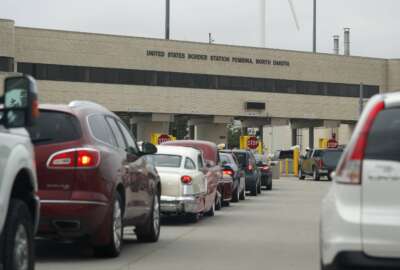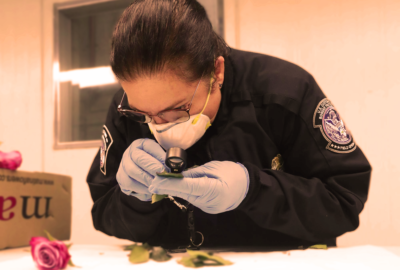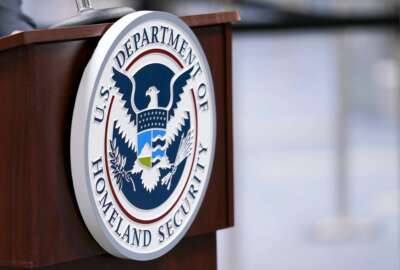
How Customs and Border Protection hopes to streamline inspections of import shipments
Customs and Border Protection wants to improve its detection of illegal and dangerous shipments coming to U.S. shores and simplify procedures for low value, low...
Customs and Border Protection wants to improve its detection of illegal and dangerous shipments coming to U.S. shores and simplify procedures for low value, low risk packages. It’s asking industry for help in expanding what the agency calls the Section 321 data pilot. We got the details from CBP’s Executive Director of Trade Policy and Programs, Brandon Lord, who spoke to the Federal Drive with Tom Temin about the pilot.
Interview transcript:
Tom Temin And you have had a project going now for several years, a pilot project called Section 321 Data Pilot. Tell us what Section 321 is of and what you’re trying to do here.
Brandon Lord Sure. And so we certainly could have come up with maybe a more catchy name. But Section 321 just refers to the process or the procedure with which low value shipments enter the United States. These are shipments under $800 or less. And the pilot looks to capture new data from new sources that traditionally, as a customs agency, we have not usually had.
Tom Temin So we’re not talking about container shipments here. We’re talking about things that might be individually sent.
Brandon Lord Yes, we are talking about small packages often shipped direct to U.S. consumers that are coming into the United States. And to give you an idea of the scale of the challenge we’re faced with, roughly two million of these small packages enter the United States every single day. U.S. Customs and Border Protection is responsible each day for screening those packages and determining which ones we want to physically inspect versus which ones we want to allow to enter into the United States.
Tom Temin And what is the routing? That is to say some of it must come from international mail carriers, but some of it must come from other shippers. I mean, you’ve got a lot of sources.
Brandon Lord Yeah, great question, Tom. It comes from everywhere. So international mail enters the United States through all manner of air carriers, including passenger carriers in the bellies of those planes. These small packages come through your traditional express operators like FedEx, UPS, DHL. They also get trucked across our northern and southern borders. Logistics providers on both sides in our northern border and southern border specialize in bringing these into the United States. We are even seeing it now in ocean ships showing up with these small packages.
Tom Temin And just a detail question before we get to the expansion, and that is packages that are coming on commercial carriers, say passenger planes, common carriers. Would those have been screened already by the equivalent in other countries of [the Transportation Security Administration] and therefore, maybe you can skip over those?
Brandon Lord Yeah. So I’m not an expert in TSA’s security and screening requirements. Our purposes, the reason why we’re looking for packages is very different than what the TSA is doing. So it’s not something that we’re able to really leverage. But again, for kind of details on that, you’d have to get with TSA.
Tom Temin Yeah, I’m just saying that if something had a bomb in it, that probably would have been detected by the originating nation before it even got on the plane. But you’re looking for things that might pass detection for that kind of danger, but be illegal for some other purpose.
Brandon Lord Yeah. So the things that we’re looking for when we screen is everything from narcotics, illegal firearms, counterfeit products that could harm the American consumer. So counterfeit makeup, counterfeit auto parts, to other products that maybe are evading other U.S. trade laws. Recently, we’ve seen a lot of biologicals coming in through the express environment where they’re misdescribed on the documents we receive. We find these biologicals and no one in our own scientific labs or even the CDC can tell us what that substance is. So some really scary stuff can come through this environment.
Tom Temin All right. And tell us about the data pilot. What is this and how can that enable more efficiency here?
Brandon Lord Yeah, absolutely. So, you know, the data pilot, we really started our efforts on developing the data pilot in October 2019, and we first announced it publicly in the summer of 2020, limited to nine participants. And what the data pilot seeks to do is to give us, Customs and Border Protection, better visibility into what is in the package itself. Who actually sent it, an actual person who actually sent it? And where is that box’s final destination? One of the things that we’re doing under this pilot, which is really fascinating for us, is we’re gathering nontraditional data, as we call it, from newer supply chain parties that maybe didn’t exist 30, 40 years ago. The last time we really looked at the regulatory environment in this small package world was in the 1970s. Well, that was before e-commerce and that was before online marketplaces. So under this data pilot, we’re now gathering data from some of those new [supply chains] on a voluntary basis and better able to identify which packages are lower risk.
Tom Temin We’re speaking with Brandon Lord, executive director of the Trade Policy and Programs Directorate at U.S. Customs and Border Protection. And what about individuals that might mail something, say, fentanyl or a gun with some ammunition, just from individual to individual that would not show up in these commercial types of situations?
Brandon Lord Yeah, well, so keep in mind, we’re only talking about packages that are mailed across the U.S. border. So packages mailed domestically, say, from Los Angeles to Reno, Nevada, or New York City, that is not within purview of this of this pilot.
Tom Temin No, understood. But someone could mail something like, I don’t know, a Kalashnikov from somewhere in Eastern Europe to someone in Texas.
Brandon Lord Absolutely. They absolutely could. So as part of this pilot, what we’re able to do is to identify those shipments that, frankly, are more legitimate than others. So participants in this pilot have seen their hold times or the number of packages that we place on hold be reduced by 90%, which allows our officers, which we have a limited number of resources, to focus on packages that we know less about. And so we have a variety of ways to detect what appear to be misdescribed packages. Nobody’s going to mail that Kalashnikov and say on that shipment, it’s a Kalashnikov, right? They’re going to call it something else. And we have ways to sort of identify that. But again, the challenge is across the country, every single day, we have over 20,000 CBP officers working at our ports of entry. And 2 million of these small packages are coming in every day. Our resources are limited. So this is an effort to explore in partnership with the private industry new ways to better identify lower risk shipments.
Tom Temin So outfits can volunteer from overseas to be part of the screening program. And they would, under this program, supply that data to CBP in advance of the shipment arriving.
Brandon Lord Correct. And not just entities overseas that are interested in this, too. So there are supply chain logistics partners that specialize in moving these packages, and they might just specialize in moving them into the United States and then putting them into the domestic mail system, which is completely illegal. There’s no laws broken doing that. Those entities have expressed interest in joining. Customs brokers who help move freight every single day on behalf of their customers have also expressed joining. Online marketplaces that sell directly to consumers have expressed joining. So there’s a lot of interest in this program, and we’re excited to see where we can take it.
Tom Temin Interesting. Yeah, there’s a lot of complications in the supply system. I mean, someone could ship a package directly to someone or they could send it to a distributor here who would then remail it or resend it by some means to someone. And so the data they give you, this is what’s in it, this is who the original sender is, this is the final destination — how do you verify that?
Brandon Lord Yes, that’s a great question. And so we we are making heavy investments as an agency into machine learning and artificial intelligence. So there are some tools around in those areas that help us verify that. But the other pieces of information that we’re gathering, things like a product photo off the Internet or even a website listing that shows the product for sale, all that information actually helps us to from a risk management standpoint. And what we’re building towards is being able to take some of that information, that product picture or that web listing of the product and cross-referencing it with our own x ray scans or other inspection tools that that we have at the ports of entry.
Tom Temin Would it be accurate to say that at this point you are testing the methods and sources to see if they work? And then would you anticipate scaling this up to everybody that ships something here?
Brandon Lord Yes, that is absolutely correct. So part of what we do any time we’re looking at changing a regulatory environment — in this case, we are — is to pilot different ideas with the trade community, with the private sector, because it is a partnership. With over 2 million small packages entering the United States every single day, we need the private sector’s cooperation and partnership in helping to identify lower risk and higher risk shipments. This is a low cost way for us to test that on a voluntary basis with with those that’re interested in partnering with us, which better informs how we move forward with regulatory changes.
Tom Temin And by the way, do some of these shipments — just as, again, my own curiosity — do they include things like food items that might be prohibited? Or plants or turtles that have fungus on them? Or, you know, your imagination can run wild?
Brandon Lord Yeah, the short answer is yes. If you can think it, we recover everything from what appear to be blank state IDs, IDs that are going somewhere in the United States, maybe to be stamped and turned into false IDs to animal products, to plant products that could carry pests and really harm our own domestic producers, to some of the products I mentioned earlier: counterfeit auto parts, counterfeit cosmetics, narcotics. To give you to give you a sense of it, last fiscal year, over 70% of our agency’s narcotics seizures occurred in this environment and over 80% of our counterfeit seizures, where we sieze something for being counterfeit occurred in this environment. We seized last year over 22 million counterfeit items as an agency across our modes, 80% of those in small package.
Copyright © 2025 Federal News Network. All rights reserved. This website is not intended for users located within the European Economic Area.
Tom Temin is host of the Federal Drive and has been providing insight on federal technology and management issues for more than 30 years.
Follow @tteminWFED
Related Stories





